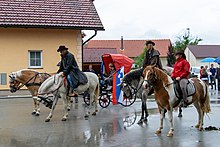
The Lipizzan or Lipizzaner is a European breed of riding horse developed in the Habsburg Empire in the sixteenth century. It is of Baroque type, and is powerful, slow to mature and long-lived; the coat is usually gray.
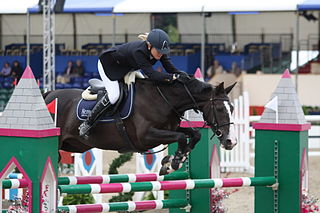
The Selle Français (SF) is a breed of sport horse from France. It is renowned primarily for its success in show jumping, but many have also been successful in dressage and eventing. An athletic horse with good gaits, it is usually bay or chestnut in color. The Selle Français was created in 1958 when several French riding horse breeds were merged into one stud book. The new breed was meant to serve as a unified sport horse during a period when horses were being replaced by mechanization and were transforming into an animal used mainly for sport and leisure.

Lipica is a village in the Municipality of Sežana in the Littoral region of Slovenia, close to the border with Italy. Lipica is one of the main tourist centers of Slovenia's Karst region and it is known for the Lipica Stud Farm, the origin of the Lipizzan horse.

The Anglo-Norman horse is a warmblood horse breed developed in Lower Normandy in northern France. A major center of horse breeding, the area had numerous regional types that were bred to one another and then crossed with Thoroughbreds to form the Anglo-Norman. Various body types developed within the Anglo-Norman breed, two of which were split off to form the Norman Cob and French Trotter. The remaining types were eventually standardized, although there remained some criticism of the "hybrid" nature of the breed's conformation. However, it is successful as an international sport horse, especially in the sport of show jumping. The Anglo-Norman also contributed to the development of several other breeds in Europe and Asia.

The Piber Federal Stud is a stud farm dedicated to the breeding of Lipizzan horses, located at the village of Piber, near the town of Köflach in western Styria, Austria. It was founded in 1798, began breeding Lipizzan horses in 1920, and today is the primary breeding farm that produces the stallions used by the Spanish Riding School, where the best stallions of each generation bred at Piber are brought for training and later public performance. One of Piber’s major objectives is "to uphold a substantial part of Austria’s cultural heritage and to preserve one of the best and most beautiful horse breeds in its original form."

The Posavac or Posavina, also known as the Croatian Posavac and the Croatian Posavina, is a breed of medium-sized draught horse with a high capacity for weight pulling. Throughout its history, the breed has been popular for pulling wagons. It is also used for forestry, agricultural and other work.

The Henson Horse, or Cheval de Henson, is a modern horse breed from northeast France. It was created by the selective breeding of light saddle horses with the smaller, heavier Norwegian Fjord horse to create small horses suitable for the equestrian vacation industry. The breeders' association, Association du Cheval Henson, was formed in 1983. In 1995 the studbook was closed to horses not born from Henson parents, and in 2003 the breed was officially recognised by the French government agencies for horse breeding. A hardy breed of horse, each winter the broodmares and youngstock from several breeders are let loose together to graze freely in the wetland reserves in France.

The Corsican is a breed of small domestic horse indigenous to the Mediterranean island of Corsica, off the coast of south-eastern France. The breed was officially recognised in February 2012, more than thirty years after the process was begun. The stud-book is kept by a breeders' association, the Association Nationale de Race U Cavallu Corsu. The total population in the island is estimated at approximately 1000. Since the stud-book was established in 2012, about 100 animals have been registered.

The Haras national du Pin is a French national stud located in Le Pin-au-Haras district, in the Orne (61) department of the southern Normandy region. It is the oldest of the French "Haras Nationaux".

The Ljutomer Trotter is a traditional breed of horse, originating in Slovenia in the town Ljutomer, where it was developed around year 1880. It is a breed of typical medium-sized warmbloods, with a majority of animals being bay. Until around 1960 animals were used for various farm tasks and transport, while today the breed is being reared and used primarily for sport purposes and recreational riding.
The Datong is a Chinese breed of small horse or pony native to northern Qinghai province. It is a sturdy pony, well adapted to life at high altitudes. As with several other Chinese horse breeds, the population is in decline.

The Barraquand horse is a French mountain horse breed. It is the result of an ancient selection process in the Vercors Massif, and it may have originated from a small herd of animals selected by religious communities, notably those established in the Léoncel abbey. It takes its name from the Barraquand family, who developed their breeding from the late 19th century to the 1950s, thanks to the practice of transhumance. Considered lost after the bankruptcy of the original Barraquand breeding operation and the sale of part of their land in 1963, the breed has been reconstituted since the 1990s, thanks to the initiative of several breeders and local institutions, in particular the Barraquand family, the Vercors Regional Natural Park and the Annecy National Stud.
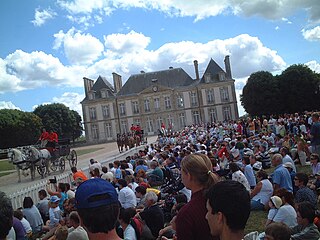
Horses in Normandy have a clear economic importance, particularly through breeding. Present since the Bronze Age, horse breeding developed with the establishment of the Haras du Pin stud farm. Horses are still a very much alive tradition in this region. Normandy boasts a number of renowned racecourses, in particular the one in Deauville, where events take place regularly, including international ones such as the 2014 World Equestrian Games.
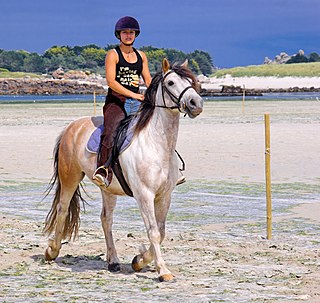
Leisure horses are intended for pleasure riding, and in particular for trail riding by private individuals. Difficult to define, it is above all an animal endowed with particular qualities, rather than a precise breed. It must be versatile and calm in character, with a willing and courageous mind. As early as the 1970s, breeders such as those of the Swiss Freiberger or Franches-Montagnes were breeding animals for this then-new use. The market for leisure horses is now buoyant. France has created "leisure qualifications" for this purpose.

The Ujumqin is a type of Chinese Mongolian horse. Larger and reputedly better conformed than other horses of this breed, it is mainly ridden, the mares being milked for their milk.
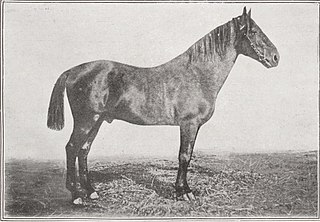
Niger was a trotter horse originated from a lineage of the now-extinct French Trotter breed. A son of The Norfolk Phœnomenon, he was a grandson or great-grandson of the English stallion The Norfolk Phenomenon. His dam, Miss Bell, was a half-blood mare of English or American origin, reputed to have served Napoleon III.

Narquois was a racehorse born in Calvados, an Anglo-Norman trotter. He was one of the first sons of the main stallion behind the French Trotter, the head of the Fuschia breed. Like him, Narquois became an excellent competitor, but at the same time was renowned for his ugliness. He usually competed in pairs with his half-sister, the mare Nitouche.

The Norfolk Phœnomenon is a black-coated stallion of the Norfolk Trotter breed. He is a son or grandson of the most famous English trotter stallion of his time, The Norfolk Phenomenon. He was imported to France in 1851 on a mission from the Haras Nationaux.

Conquérant was a founding stallion of the French Trotter horse breed, born in 1858 in Cotentin, Normandy, to breeder Pierre Étienne Joseph-Lafosse, and died in 1880. Son of the mare Élisa and the stallion Kapirat, descended through him from the almost Thoroughbred Young Rattler, he had an excellent racing career in mounted trotting for the Basly stable. Sold to the Haras Nationaux in 1862 after his racing career, Conquérant became a sought-after sire of 66 trotters.






